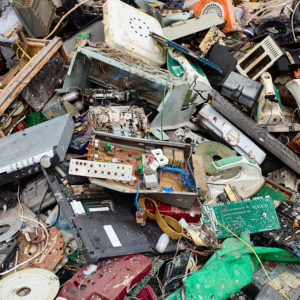Most of us do what we can to preserve the environment, no matter how large or small the effect. It’s no secret that if we do not radically change our habits, our world will suffer as a result. For many of us, that means recycling our aluminum cans and plastic bottles, carpooling when we can, conserving water, and buying local.
However, it is important to understand that consumers can only do so much when it comes to saving the planet. A lot of our habits and standards are set forth by corporations and conglomerates who shape our society’s waste production in a major way. Whether they are producing pollution themselves, or encouraging a lifestyle full of waste, corporations hold a large portion of the blame when it comes to climate change.
The tech industry is a significant source of this negative corporate influence. Though their tactics may not be as obviously harmful as the oil or deforestation industries, the tech industry creates a significant drain on the environment as well. As many of us can attest, smartphones, laptops, smart watches, and headphones all upgrade constantly, creating a waste issue that few are talking about.
Fortunately, there may be a way to slow down this tech waste machine, and it’s so important that the US government is stepping in to help.
The Upgrade Issue
 There is a clear standard in the United States when it comes to upgrading tech products. Most of us estimate that we’ll have our phones for two years before our mobile carriers offer a low cost option to upgrade and resign our contracts. This has become so prevalent in the fabric of our society that we barely think about it.
There is a clear standard in the United States when it comes to upgrading tech products. Most of us estimate that we’ll have our phones for two years before our mobile carriers offer a low cost option to upgrade and resign our contracts. This has become so prevalent in the fabric of our society that we barely think about it.
It is important to note that this is a unique situation in the United States specifically. Even in other developed countries, such as the UK, individuals do not upgrade their phones with such frequency. In developing countries, the ability to own a smartphone is a privilege that many do not possess. In India, for example, It can require two month’s salary to purchase even the most basic smartphone.
The Necessity Of Upgrades
Some upgrades are simply necessary. Our phones break, we drop them into a puddle, our kids smear them with peanut butter, and so on. So, yes, sometimes a phone upgrade is necessary. What should be considered, however, is why this “two year” standard has become so entrenched in our society. Should we automatically upgrade every two years, even if our phone functions well? The answer, from an ecological standpoint, is no.
A Compounded Issue
This issue is further exacerbated by the fact that our phones are not designed to last. Planned obsolescence creates a huge drain on resources, and creates unnecessary waste without consumers doing anything wrong. If our tech is made to break down, we have no choice but to upgrade or replace our broken devices.
Another large factor is the exorbitant cost of repairing our devices. Replacing a broken screen or camera lens can be as expensive (or more expensive) than simply upgrading or buying a new phone. For lots of people, choosing the sustainable option of fixing broken tech rather than replacing it is simply not possible. This is where the United States government is stepping in.
What Is ‘Right To Repair?’
As of right now, most of us are forced to bring our tech devices into a professional store or specialist in order to get them fixed. Though the problem may only be a broken screen or a faulty button, we don’t have the know-how to correctly address the issue ourselves. ‘Right to repair’ changes all of that. This idea suggests that individuals have the right to access basic repair information about the products they use. This way, if an individual would like to fix the issue themselves, they have the information necessary to do so.

How Is The Government Getting Involved With ‘Right To Repair?’
The ‘right to repair’ is part of an executive order introduced by president Biden in July of 2021. This concept tells us that consumers have the power to fix their own equipment if they would like to do so. This means that an individual should not have to choose between working with broken equipment, forgoing the equipment altogether, and replacing the equipment at high cost.
Now, the US government is ensuring that all consumers have access to diagnostic and repair instructions from the product’s manufacturer, ensuring that they can attempt to repair their property.
This presents consumers with an incentive to repair instead of replace, especially when an issue is minor. If instructions are readily available, it often makes sense to fix existing products instead of buying new ones.
What Does Right To Repair Mean For The Environment?
When it comes to the environment, ‘right to repair’ has significant benefits. As of right now, thousands of tech devices are discarded monthly because they have minor, fixable issues. While some of these consumers may simply want to upgrade rather than fix their devices, others do not have a choice due to the financial burden of repair costs. With ‘right to replace,’ hundreds of consumers will keep their tech products out of landfills, and in their pockets.
 This means less discarded products with only minor issues. Because tech products often have mercury and other toxic materials inside of them, keeping them out of landfills helps to reduce toxic chemicals from being put back into the environment. Between lower production rates and less waste, this new standard is a win for the environment.
This means less discarded products with only minor issues. Because tech products often have mercury and other toxic materials inside of them, keeping them out of landfills helps to reduce toxic chemicals from being put back into the environment. Between lower production rates and less waste, this new standard is a win for the environment.
What If I Don’t Want To Fix It Myself?
This change does not force anyone to do their own tech repairs at home. For many, even the clearest instructions would not lead to a successful repair. What the change does is ensure that small retailers and tech repair professionals could offer high quality repairs from their stores. Rather than simply guessing how a phone should be fixed, these talented individuals would have a guidebook to do all repairs correctly and safely. It is more likely that your small, independent tech stores will be able to compete with the services of the tech manufacturers themselves.
What ‘Right to Repair’ Means For The Tech Industry
The ‘right to repair’ clause will likely have a significant impact on the tech industry, but it is difficult to hypothesize how. It will likely slow down production at least a little bit, as there will be slightly less demand for new products. However, it would be naive to assume that this legislation will break our society’s need for upgraded technology. Though it does give people the option, many of us are so addicted to new tech that we won’t exercise our right to choose repair over replacement.
What will likely happen is a drop in repair prices from major technology retailers. Because the information needed for device repair will be readily available online, independent tech stores and individuals will be able to provide repairs at much lower cost. In order to compete, the major retailers will likely need to drop their repair prices, at least a little bit.
The Connection To Tech Monopoly

One of the largest economic blunders that has come to light with this executive order is the fact that our country has been living in a type of tech monopoly for years. Though we have options when it comes to choosing the devices themselves, once we’ve signed a contract, we are essentially bound to seek repairs from the phone’s manufacturer. If we would rather not have our device repaired when it breaks, we have to replace our device or live without it. The options have been shockingly limited, and we have all gone along with it.
The “right to repair” executive order ensures that tech companies cannot hold monopolies on device repair. The consumer has options when it comes to broken devices, and is free to make whichever decision is best for their situation. It’s likely that many may still seek manufacturer repairs or overall replacements, and that is their prerogative. Others may take the economic and environmentally-conscious choice to repair their existing devices. Either way, the power is in the hands of the consumer, not the silicon valley tech giants.
Influence On 2 Year Renewal Plans
It will certainly be interesting to see how these changes affect the standard two year replacement window for cell phones. While tech giants will undoubtedly keep updating their options, many people may feel less pressured to upgrade if they can keep their old device in peak working order with repairs. Because repair prices will likely go down due to new market competition, repairs may be the only option for those who need to save money and budget.
Most importantly of all, however, is our ability to consider the environment when we look at buying a new cell phone. It is possible that reusing, handing down, or recycling phones will become more sought after, as affordable repairs can keep them running well for longer. The ‘right to repair’ truly opens the door for environmental consideration, and (hopefully) a more sustainable future.

Browse The Boon Room
Expand your eco-friendly life and support a sustainable future. At The Boon Room, we advocate for sustainable practices in every industry, and help individuals understand what it means to be eco-friendly. With approachable information, tips on how to reduce waste, and judgment-free discussions about our environment, our site is a great accompaniment to your sustainability journey.
For information on how to take action, sustainable product swaps, eye opening exposes, and more, sign up for our mailing list and follow us on all social media platforms today!

The Boon Room is more than a website, brand or service. It’s an idea. It’s a project. It’s a mission. It’s a coming together of companies, investors, cultivators, manufacturers, distributors, retailers and inspired entrepreneurs who believe businesses need to look for ways to invest in sustainablity.

